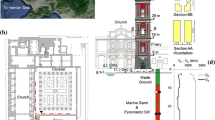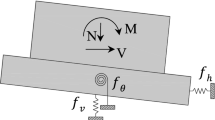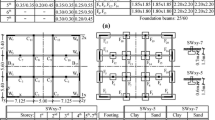Abstract
The manuscript deals with the dynamic interaction between the seismic response of a masonry bell-tower and the soil layer below its foundations. The study is based on a direct soil-structure interaction analysis, by means of a complete 3D FEM model in which, beside the non-linear behaviour of the masonry material, a large portion of the foundation soil is taken into account, assuming a condition of non-reflection of the elastic waves within the domain of interest by means of infinite elements. A fairly refined description of the tower geometry allowed a thorough examination of the interaction between the characteristics of the motion transmitted from the ground and the damage mechanisms of the tower, which may include crack patterns related to the second mode of vibration and the collapse of the belfry. The results of modal analyses highlighted the extent to which the soil deformability modifies the shape of second natural vibration modes of the tower. A relevant reduction of the high frequency content of the vertical component at the base of the tower was also observed, especially in the case of a more deformable soil. In the non-linear dynamic analyses, a constitutive relation with plasticity and damage for the walls material was assumed, while as forcing actions, the strong ground motions recorded in Mirandola during the shock of May 29, 2012, and in Gemona during the Friuli Earthquake on September 15, 1976 were assumed. These analyses allowed us to investigate two main issues: (1) the capability to take into account the higher vibration modes, which tend to have a relevant role in the damage of the upper part, especially the tower crown and belfry; (2) the specific effect of the vertical component of ground acceleration, usually considered quite relevant for this structural typology. The damage scenarios obtained in a condition of deformable foundation soil resulted different from those obtained in the hypothesis of a fixed base support. In this case, the resort to non-linear dynamical models, which also include a significant volume of deformable soil, is recommended in order to perform an accurate assessment of damage scenarios.

















Similar content being viewed by others
Notes
The scalar damage variable d (d c in compression and d t in tension) is representative of the stiffness degradation of the material, thus (1 − d) is the ratio of the effective load-carrying area (i.e., the overall area minus the damaged area) to the overall section area.
η = fij/f0j. The first index denotes the Id of the FE model considered, whereas the second index denotes the natural mode.
α = fi1/fi2.
The modal shapes are previously depurated from rigid-body motions and then normalized to unity at the top of the structure.
The accelerograms of ITACA database, shown in Fig. 10.
In Eq. (13), if the denominator is \({\text{FT}}\left[ {{\text{a}}\left( {z = H,f} \right)} \right]\) one may have values zero or very close to zero (at least for some frequencies), causing many spikes. A water-level regularization (Clayton and Wiggins 1976) can reduce this phenomenon, by introducing a scalar value w (called critical level) and adjusting \({\text{FT}}\left[ {{\text{a}}\left( {z = H,f} \right)} \right]\) only when its modulus is lower than w. Thus it is possible to write:
\(\widetilde{\text{FT}}\,\left[ {{\text{a}}\left( {z = H,f} \right)} \right] = \left\{ { \begin{array}{*{20}l} {FT\left[ {{\text{a}}\left( {z = H,f} \right)} \right] ,} \hfill & {if\;\left| {{\text{FT}}\left[ {{\text{a}}\left( {z = H,f} \right)} \right]} \right| > w} \hfill \\ {w\frac{{{\text{FT}}\left[ {{\text{a}}\left( {z = H,f} \right)} \right]}}{{\left| {{\text{FT}}\left[ {{\text{a}}\left( {z = H,f} \right)} \right]} \right|}},} \hfill & { if\; 0 < \left| {{\text{FT}}\left[ {{\text{a}}\left( {z = H,f} \right)} \right]} \right| \le w} \hfill \\ {w, } \hfill & { if\;\left| {{\text{FT}}\left[ {{\text{a}}\left( {z = H,f} \right)} \right]} \right| = 0} \hfill \\ \end{array} } \right.\) where \(\widetilde{\text{FT}}\left[ {{\text{a}}\left( {z = H,f} \right)} \right]\) is the regularized Fourier Transform of \({\text{a}}\left( {z = H,f} \right)\). The same considerations are referred to TF(f) in Eq. (14).
References
ABAQUS (2014) ABAQUS documentation version 6.14. Dassault Systèmes, Providence, RI
Acito M, Bocciarelli M, Chesi C, Milani G (2014) Collapse of the clock tower in Finale Emilia after the May 2012 Emilia Romagna earthquake sequence: numerical insight. Eng Struct 72:70–91
Allemang RJ, Brown DL (1982) A correlation coefficient for modal vector analysis. In: Proceedings, international modal analysis conference, pp 110–116
Barbieri G, Biolzi L, Bocciarelli M, Fregonese L, Frigeri A (2013) Assessing the seismic vulnerability of a historical building. Eng Struct 57:523–535
Bartoli G, Betti M, Vignoli A (2016) A numerical study on seismic risk assessment of historic masonry towers: a case study in San Gimignano. Bull Earthq Eng 14:1475–1518
Binda L, Gatti G, Mangano G, Poggi C, Sacchi Landriani G (1992) The collapse of the civic tower of Pavia: a survey of the materials and structure. Mason Int 6(1):1–20
Burban A, Maity D, Sreedeep S (2010) Iterative analysis of concrete gravity dam-nonlinear foundation interaction. Int J Eng Sci Technol 2(4):85–99
Camata G, Cifelli L, Spacone E, Conte J, Torrese P (2008) Safety analysis of the bell tower of Santa Maria Maggiore Cathedral in Guardiagrele. In: WCEE, the 14th world conference on earthquake engineering, Beijing, China
Casolo S (1998) A three-dimensional model for vulnerability analysis of slender medieval masonry towers. J Earthq Eng 2(4):487–512
Casolo S, Uva G (2013) Non-linear dynamic analysis of masonry towers under natural accelerograms accounting for soil-structure interaction COMPDYN 2013. Kos Island, Greece
Casolo S, Milani G, Uva G, Alessandri C (2013) Comparative seismic vulnerability analysis on ten masonry towers in the coastal Po Valley in Italy. Eng Struct 49:465–490
Clayton RW, Wiggins RA (1976) Source shape estimation and deconvolution of teleseismic bodywaves. Geophys J Int 47(1):151–177
Curti E, Lagomarsino S, Podestà S (2006) Dynamic models for the seismic analysis of ancient bell towers. In: Lourenço PB, Roca P, Modena C, Agrawal S (eds) Proceedings of structural analysis of historical constructions SAHC. MacMillan, New Delhi
Doglioni F, Moretti A, Petrini V (1994) Le Chiese e il Terremoto. Lint Press, Trieste
Gentile C, Saisi A, Cabboi A (2015) Structural identification of a masonry tower based on operational modal analysis. Int J Archit Herit 9(2):98–110
Giresini L (2016) Energy-based method for identifying vulnerable macro-elements in historic masonry churches. Bull Earthq Eng 14:919–942
Guéguen P, Bard PY (2005) Soil-structure and soil-structure–soil interaction: experimental evidence at the Volvi test site. J Earthq Eng 9(5):657–693
ITACA Working Group (2016) ITalian ACcelerometric Archive, version 2.1. doi:10.13127/ITACA/2.1
Ivorra S, Pallares FJ (2006) Dynamic investigations on a masonry bell tower. Eng Struct 28:660–667
Ivorra S, Pallarés FJ, Adam JM, Tomás R (2010) An evaluation of the incidence of soil subsidence on the dynamic behaviour of a Gothic bell tower. Eng Struct 32(8):2318–2325
Ivorra S, Brotóns V, Foti D, Diaferio M (2016) A preliminary approach of dynamic identification of slender buildings by neuronal networks. Int J Non-Linear Mech 80:183–189
Kouroussis G, Verlinden O, Conti C (2011) Finite dynamic model for infinite media: the corrected solution of viscous boundary efficiency. J Eng Mech
Kramer SL (1996) Geotechnical earthquake engineering (Prentice-Hall international series in civil engineering and engineering mechanics). Pearson Education
Kuhlemeyer RL, Lysmer J (1973) Finite element method accuracy for wave propagation problems. J Soil Mech Found Div Am Soc Civ Eng 99(SM5):421–427
Lee J, Fenves GL (1998) A plastic-damage model for earthquake analysis of dams. Earthq Eng Struct Dyn 27:937–956
Lourenço PB (2002) Computations of historic masonry constructions. Prog Struct Eng Mater 4(3):301–319
Lubliner J, Oliver J, Oller S, Onate E (1989) A plastic-damage model for concrete. Int J Solids Struct 25(3):299–326
Luco JE, Trifunac MD, Wong HL (1988) Isolation of soil-structure interaction effects by full-scale forced vibration tests. Earthq Eng Struct Dyn 16(1):1–21
Luzi L, Hailemikael S, Bindi D, Pacor F, Mele F, Sabetta F (2008) ITACA (ITalian ACcelerometric Archive): a web portal for the dissemination of italian strong-motion data. Seismol Res Lett 79(5):716–722
Lysmer J, Kuhlemeyer RL (1969) Finite dynamic model for infinite media. J Eng Mech Div ASCE Am Soc Civ Eng 95(EM4):859–877
Milani G, Valente M (2015) Failure analysis of seven masonry churches severely damaged during the 2012 Emilia-Romagna (Italy) earthquake: non-linear dynamic analyses vs conventional static approaches. Eng Fail Anal 54:13–56
Milani G, Valente M (2016) Non-linear dynamic and static analyses on eight historical masonry towers in the North-East of Italy. Eng Struct 114:241–270
Milani G, Casolo S, Naliato A, Tralli A (2012) Seismic assessment of a medieval masonry tower in Northern Italy by limit, non-linear static and full dynamic analyses. Int J Archit Herit 6(5):489–524
Pacor F, Paolucci R, Luzi L, Sabetta F, Spinelli A, Gorini A, Nicoletti M, Marcucci S, Filippi L, Dolce M (2011) Overview of the Italian strong motion database ITACA 1.0. Bull Earthq Eng 9(6):1723–1739
Pena F, Lourenço PB, Mendez N, Oliveira D (2010) Numerical models for the seismic assessment of an old masonry tower. Eng Struct 32:1466–1478
Pintucchi B, Zani N (2014) Effectiveness of nonlinear static procedures for slender masonry towers. Bull Earthq Eng 12:2531–2556
Stewart JP, Fenves GL (1998) System identification for evaluating soil-structure interaction effects in buildings from strong motion recordings. J Earthq Eng Struct Dyn 27:869–885
Van Der Pluijm R (1993) Shear behavior of bed joints. In: Proceedings of the 6th North American Masonry conference, pp 125–136
Veletsos AS, Meek JW (1974) Dynamic behavior of building foundation systems. J. Earthq Eng Struct Dyn 3(2):121–138
Yerli HR, Kacin S, Kocak S (2003) A parallel finite–infinite element model for two dimensional soil-structure interaction problems. Soil Dyn Earthq Eng 23:249–253
Zienkiewicz OC, Emson C, Bettess P (1983) A novel boundary infinite element. Int J Numer Methods Eng 19(3):393–404
Zienkiewicz OC, Bando K, Bettes P, Emson C, Chiam TC (1985) Mapped infinite elements for exterior wave problems. Int J Numer Methods Eng 21(7):1229–1251
Author information
Authors and Affiliations
Corresponding author
Rights and permissions
About this article
Cite this article
Casolo, S., Diana, V. & Uva, G. Influence of soil deformability on the seismic response of a masonry tower. Bull Earthquake Eng 15, 1991–2014 (2017). https://doi.org/10.1007/s10518-016-0061-y
Received:
Accepted:
Published:
Issue Date:
DOI: https://doi.org/10.1007/s10518-016-0061-y




